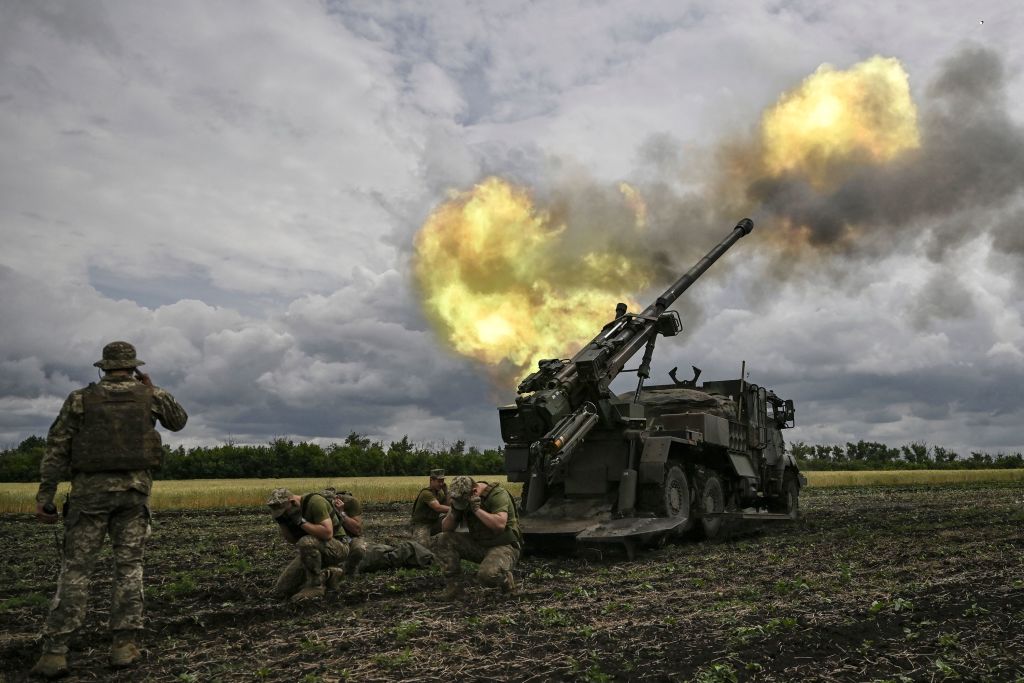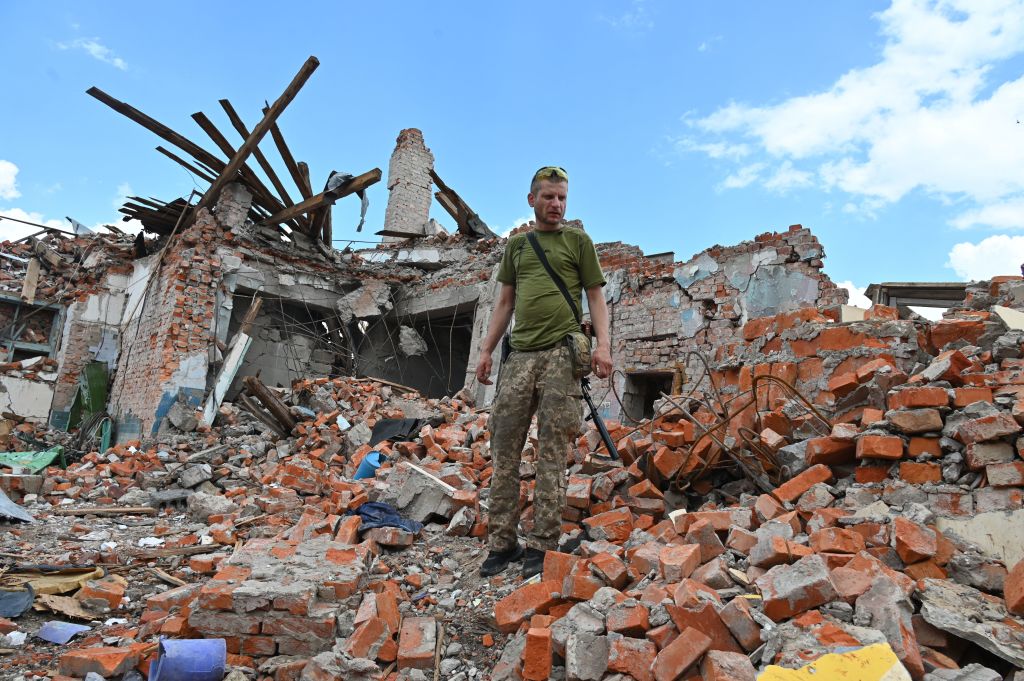The West looked on in horror on February 24 as Russia launched a full-scale invasion of Ukraine. Since the war broke out, bloody fighting and attacks on civilians have resulted in at least tens of thousands of deaths, the displacement of 12 million Ukrainians abroad or within the country, and at least $100 billion of infrastructure damage. And nearly five months in, there’s no end in sight to the brutal conflict.
While Russian President Vladimir Putin’s forces continue to pursue his war aims, Ukraine’s armed resistance has impressed the West by facing down a much larger opponent. Following Ukrainian successes early on in the war, Russia has turned its attention towards Ukraine’s easternmost Donbas border region—and the more recent phase of the war has been going more in Moscow’s favor. Still, analysts tell TIME that it could be a long road ahead, with negotiations largely abandoned and fierce fighting ongoing.
Here, the current situation in Ukraine, what it means for the West, and what could happen next:
Where the war stands
Russia initially took a “shock and awe approach,” says Mark Cancian, a senior security adviser at the Center for Strategic and International Studies, a Washington, D.C.-based think tank. The aim was to overwhelm Ukrainian forces and prompt a change of government that would be friendly to Moscow. This involved widespread airstrikes in key cities to “soften up targets,” Cancian says, followed by large-scale infantry attacks along four main axes—towards the capital Kyiv in the north, the second-largest city Kharkiv in the northeast, the Donbas region in the east, and the areas above Crimea, which Russian annexed in 2014, in the south.
But with Ukrainian success, including President Vlodomyr Zelensky refusing to flee the capital, this approach failed. Russian troops retreated in early April from Kyiv and have now turned their attention to eastern and southern regions—particularly the Donbas, home to two breakaway states that have been under pro-Russian separatist control since 2014. With Russia having expended most of its long-range missiles, the conflict has become “a slow grinding war of attrition” on the frontlines, with either side advancing or retreating “inch by inch,” explains Angela Stent, a non-resident senior fellow at the Washington, D.C.-based Brookings Institution.
Read more: TIME’s Interview with Volodymyr Zelensky
Although airstrikes away from the frontlines are now “limited,” Cancian says, Russia still fires missiles every couple of weeks at cities. Last month, two residential buildings in Kyiv were hit as the G7 summit got underway in Germany, in what the city’s mayor Vitali Klitschko called a “symbolic” attack.
Ukraine has had several disadvantages from the start, including being unable to match the heavy weaponry of Russian forces. Although foreign governments are increasingly sending Ukraine more advanced weapons, it takes time to train Ukrainian troops who have relied on Soviet-era calibers, Cancian says. Earlier this month, the U.S. committed to sending additional mid-range rocket-launching systems known as HIMARS. Recent reports suggest HIMARS may be turning the war back in Ukraine’s favor.

Fighting is brutal on the frontlines—last month, Zelensky said that Ukraine was losing up to 200 troops a day. Russia will be losing the same number of troops, if not more, Brookings’ Stent says. Despite such heavy losses, analysts predict that the war could go on for years. “Both sides are now gearing [up] for a long war—recruiting, training, finding replacements—and moving from what you might call the sprint phase to a marathon phase,” Cancian says.
And successful peace negotiations at this stage seem unlikely. “We haven’t started anything yet,” Putin said in a speech to lawmakers July 7. “Today we hear that they want to defeat us on the battlefield. What can you say, let them try,” he said. Although Putin didn’t rule out peace talks, he said it would get “harder” to negotiate the longer the war goes on. “One thing we do know is that Putin is very patient, and he can’t withdraw until he says that he’s had a victory,” Stent says.
For Ukraine’s part, Zelensky has made it clear that Ukraine will fight to regain control of the fallen regions. “Ukrainians are not ready to give away their land, to accept that these territories belong to Russia. This is our land,” Zelensky said in an interview with CNN on July 7.
The territory Russia has gained
Fighting is concentrated on frontlines in Ukraine’s eastern and southern regions, particularly in the Donbas. On July 3, Russian Defense Minister Sergei Shoigu told Putin that their forces had established “full control” of Lysychansk, the last Ukrainian-controlled city in the eastern Luhansk region. In effect, Moscow now controls the entire Luhansk region and more than half of the Donetsk region that lies just south, and which together comprises 75% of the Donbas. Ukraine also conceded Severodonetsk just north of Lysychansk on June 25 after weeks of some of the war’s bloodiest fighting.
“Russian forces are entrenched in the area of Lysychansk and the city is on fire,” said Serhiy Haidai, the governor of the Luhansk region. Many of the captured cities have been razed to the ground.
In the west of Donetsk, Ukrainian forces are continuing to hold back Russian attacks towards Sloviansk from the direction of Izyum, according to the Institute for the Study of War. And beyond the Donbas, further north, Russian units are vying for control of positions north of Kharkiv.
In the south, after a bloody siege lasting more than two months, Russia gained full control of the port city of Mariupol in late May, helping to create a land corridor between Russian-controlled Crimea and Donetsk and Luhansk. Strong resistance from Ukrainian forces significantly slowed Russia’s advance, however, leaving Russian troops “pretty exhausted,” says Cancian.
Amid the fighting, there have been widespread reports of war crimes and attacks on civilians by Russian forces in Ukraine. According to Ukrainian prosecutor general Iryna Venediktova, some 21,000 alleged war crimes are being investigated, with between 200 to 300 new reports arriving every day. A senior U.N. official expressed concern in June at the mounting number of cases of sexual violence being reported against Ukrainian civilians.

European leaders and judicial authorities met in the Hague on July 14 to coordinate investigations into Russian atrocities, with the sharing of evidence, prosecution strategy, and international war crimes expertise to investigators on the ground.
Read more: Ukrainians Are Speaking Up About Wartime Rape
NATO’s response to the war
NATO members have sent billions of dollars of military aid to Ukraine, including crucial weaponry, without which the country would’ve been defeated “in two or three weeks,” says Cancian.
Stent explains that one of the “unintended consequences” of Russia’s invasion is NATO’s renewed unity. At the 2022 NATO summit in Madrid last month, leaders of the 30 NATO members agreed to increase the allied military presence in eastern Europe, and on the final day Turkey withdrew its objection to Sweden and Finland’s application to join the defensive alliance. With a rapidly expanding defense budget strengthening its already advanced military capabilities, Finland’s addition to the alliance in particular will bolster NATO’s military capabilities, but open a new 830-mile border between it and Russia.
Russia’s attack on Ukraine has more broadly pushed European countries to expand their military spending—on June 3 Germany approved a €100 billion ($100.5 billion) investment package to modernize its chronically underfunded armed forces. “NATO has faced a real test and come out stronger,” Cancian says.
Read more: The Risks of NATO’s Rebirth
Russia’s invasion has also pushed NATO to abandon the “tripwire” strategy of deterrence deployed after Russia’s annexation of Crimea, which involves smaller forces stationed in high-risk areas that can be reinforced in case of attack. Instead, NATO is moving back towards a strategy of fortifying defensive positions. In late June, NATO said it will increase its forces on high-alert by more than seven-fold, and the U.S. announced it will construct its first permanent base on the alliance’s eastern flank, in Poland. Amid the news, President Joe Biden said the U.S. would “defend every inch of allied territory.”

This is key, Cancian says, to “signal to Putin that he cannot come further west.”
What about energy and grain supplies?
Turkey, a country with the second largest standing army among NATO members, brokered a deal on July 14 with Russia, Ukraine, and the U.N. to resume Ukrainian grain exports that had been blocked by Moscow. The disruption in global grain supplies precipitated by the war—Russia and Ukraine account for nearly one-third of the world’s wheat supplies—has exacerbated food security, particularly in African and Middle Eastern countries, due to both higher prices and supply issues.
Despite the success of these negotiations over grains, the Brookings’ Stent worries that the squeeze on energy supply chains—either as a result of the war or sanctions on Russia—will make it “increasingly difficult to sustain Western unity” in the long term. Russia has already cut gas supplies to Europe and a Shell chief has warned Europe may have to ration energy this winter.
Read more: The Food Crisis Can’t Handle Ukraine War and Climate Change
As the fallout from the war piles up around the world, there could be more pressure on Ukraine to make concessions to bring about an end to the conflict and its knock on effects. Though, as “neither side has indicated any willingness to do that,” says Cancian, the conflict looks set to be what Stent calls a “slow, grinding war.”
More Must-Reads from TIME
- Cybersecurity Experts Are Sounding the Alarm on DOGE
- Meet the 2025 Women of the Year
- The Harsh Truth About Disability Inclusion
- Why Do More Young Adults Have Cancer?
- Colman Domingo Leads With Radical Love
- How to Get Better at Doing Things Alone
- Michelle Zauner Stares Down the Darkness
Contact us at letters@time.com